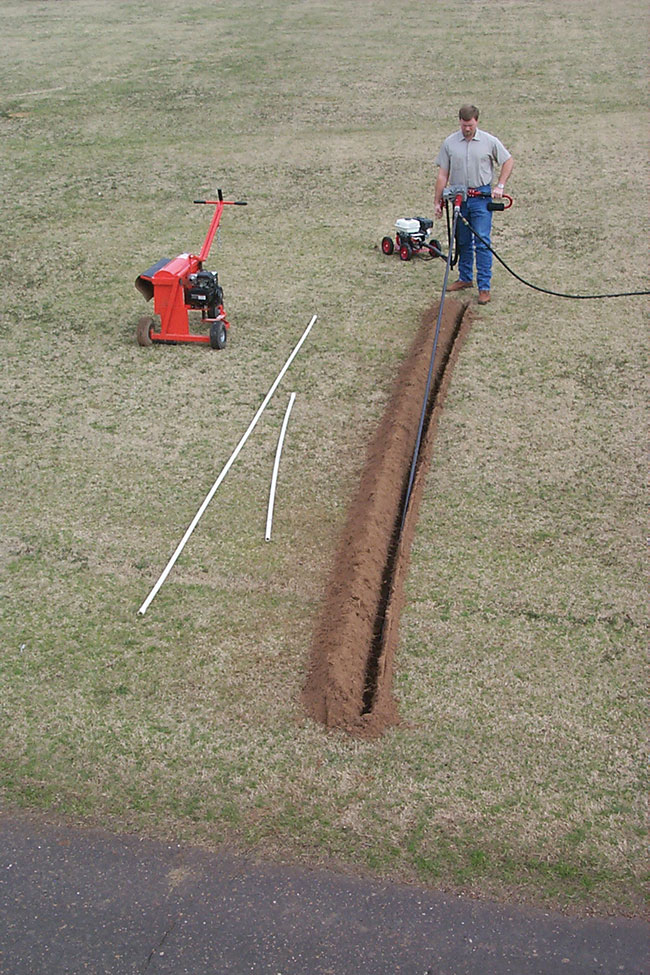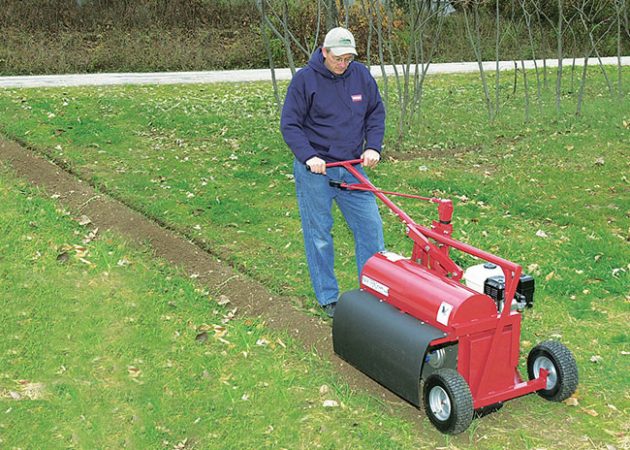
Features
Equipment
Landscaping
Small trenchers for small applications in landscaping
Mini trenchers permit easy digging for smaller jobs
February 23, 2022 By Joe Haynes
 Some mini trenchers feature pneumatic tires that don’t affect turf. This benefits customers because they won’t have to spend extra time repairing damaged turf caused by tracked machines, skid steers or other self-propelled units like chain-driven trenchers.
Photo credit: Little Beaver.
Some mini trenchers feature pneumatic tires that don’t affect turf. This benefits customers because they won’t have to spend extra time repairing damaged turf caused by tracked machines, skid steers or other self-propelled units like chain-driven trenchers.
Photo credit: Little Beaver. Working on a trenching project means different things to different people. Applications vary as much as the required trench depth and width. To some, a trench needs to be several feet wide and deep to place a culvert for drainage. For others, it is a shallow channel in which they can bury low voltage wiring or water lines for sprinkler systems.
Just as the applications vary, so do the solutions to efficiently tackle these applications. Mini trenchers offer versatile equipment solutions that take on a wide variety of applications and provide quick results.
Landscape contractors appreciate the easy handling and operation of small trenchers over manual digging or using a large, chain-driven trencher, which costs almost 10 times as much as a mini trencher.
Mini applications
Mini trenchers offer operators an ideal solution for shallow depth trenching, about 12 inches deep and two inches wide. This type of trenching works for a variety of applications, from sprinkler systems to electric underground dog fences to cutting trenches for propane. It also easily takes on surface root pruning and installing plumbing and drainage lines, as well as low voltage wiring, such as satellite dish, cable or phone lines or landscape lighting wires.
Speedy ROI
Compared to bulky-to-manoeuvre and intimidating chain-driven trenchers or the back-breaking work of shoveling by hand, mini trenchers cut through tough soils fast without strain. They’re easy to handle, offer fast cutting speeds, cut cleanly and reduce worksite damage – all benefits to an operator’s efficiency.
Safety and simplicity will further impact efficiency. Mini trenchers that allow operators to push the unit by walking forward rather than backward give users full control and enhance safety by enabling consistent sight of their travel path. Some forward walking units cut as fast as 30 feet per minute, which helps customers accomplish tasks quickly, especially when compared to larger chain-driven trenchers. Using a mini-trencher saves time and trenches 20 per cent faster than chain-driven units that are cumbersome to move and expensive to buy.
Trenching is only half the job. Backfilling and cleanup requires time and effort as well, so it’s important to look for designs that minimize cleanup. Search for a mini trencher that piles dirt neatly to one side. This can reduce backfill times by as much as 50 per cent over those models that kick it out to both sides. Not only does that cut backfill and cleanup time, but it creates less of a mess. It also minimizes soil cupping since the trench is narrow and allows for the area worked to rehabilitate back to its natural state quickly.
Consider mini trenchers that feature pneumatic tires that don’t affect turf. Contractors won’t have to spend extra time repairing damaged turf caused by tracked machines, skid steers or other self-propelled units like chain-driven trenchers.

A landscape contractor might look for a mini-trencher to cut a trench for sprinkler systems or for low-voltage wiring or landscape edging.
Long-lasting value
Mini trenchers that feature replaceable blades and teeth give contractors more options for different soils. A mini trencher with heavy-duty rock teeth easily handles tough, rocky soil areas and even cuts through asphalt. The same mini trenchers also come equipped with a cutting blade option more suited for loose, sandy soil types.
Required maintenance also impacts overall value and ROI. And it could mean the difference between staying productive on the job and experiencing downtime waiting on lengthy repairs. Mini trenchers that incorporate a built-in slip clutch guard the drive train from shock if the trencher hits a rock or obstacle by stopping the blade from turning, protecting the equipment. It also protects the cutter teeth and belt from excessive wear and damage. Look for models that feature bolt-on blades or cutting teeth so replacement will be simple and inexpensive. Some models weld teeth directly on the cutting wheel, causing the entire wheel to need replacement when a single tooth is damaged.
Final cut
Mini trenchers are a versatile and valuable tool for a wide variety of landscaping applications. These units help operators decrease damage and get trenching projects done quickly. Just because they are mini doesn’t mean users will see a small return on their trencher investment.
Joe Haynes is president of Little Beaver, a three-generation-long manufacturer of drilling equipment, including augers, extensions, points and blades.
Print this page